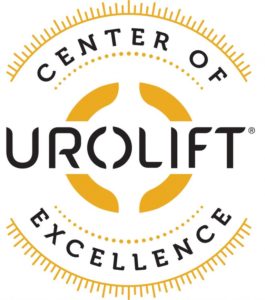Northeast Georgia Physician Group Urology offers a number of treatment options for enlarged prostate and other prostate issues, including an innovative solution called UroLift®. We have been designated as a UroLift® Center of Excellence and we offer an alternative to prescription medications used to treat enlarged prostate (BPH), which may not provide adequate relief for some people or may cause unwanted side effects.

About the UroLift® System
A one-time, surgical procedure, the UroLift® system implants are placed with a delivery device through the urethra allowing improved flow through the prostate. These implants lift and hold the enlarged prostate tissue out of the way, opening the obstructed urethra, providing lasting relief for people experiencing issues because of an enlarged prostate. The procedure can be done either in-office or in a surgery center. Patients can typically expect a speedy recovery and go home immediately after the procedure.
Benefits of the UroLift® System
This system typically enables patients to:
- Preserve sexual function
- Reduce unwanted side effects from medication
- Avoid more invasive surgical procedures to treat enlarged prostrate
If you are experiencing symptoms or are actively treating BPH, our board-certified urologists can help identify the right treatment path for you in order to relieve symptoms and ensure outcomes that fit your lifestyle. If you would like to learn more about UroLift®, as a UroLift® Center of Excellence, NGPG Urology provides expertise and better outcomes. Contact Dr. David Stanley’s office today to learn more about this procedure and whether it would be a fit for you.
If you and your doctor decide that the UroLift® System treatment is right for you, your doctor will provide you with more detailed information relating to the treatment. In general, the UroLift® System is a minimally invasive treatment that entails minimal downtime. Your doctor will use the UroLift® Delivery Device to deploy permanent implants to relieve obstruction caused by the enlarged prostate that is pressing on your urethra. The procedure, which usually takes less than an hour, may be performed under local or general anesthesia and you may be given medication to feel comfortable during the treatment. This typically helps minimize discomfort during the procedure, though everyone’s definition for pain and discomfort varies greatly. Typically, no catheter and no overnight stay is required post-treatment.
After the treatment, patients typically go home the same day without a catheter. There is minimal downtime post-treatment and many patients experience symptom relief in as early as 2 weeks. Patients may experience some urinary discomfort during the recovery period. Most common side effects are mild to moderate and include pain or burning with urination, blood in the urine, pelvic pain, urgent need to urinate and/or the inability to control the urge. Most symptoms resolved within two to four weeks after the procedure.
Clinical studies have shown the UroLift® System treatment does not cause new, sustained instances of erectile or ejaculatory dysfunction. The same cannot always be said of other BPH therapies such as TURP, laser, and even medication.
The UroLift® System treatment is covered by Medicare and many private insurers. Contact your insurance provider or our offices for more information about insurance coverage.
Get Started
Contact Dr. David Stanley, FACS, at NGPG Urology to learn more about the UroLift® System, or call us to request an appointment with our practice to explore your treatment options for enlarged prostate.
Dr. David Stanley is a board-certified urologist who has earned the distinction as a UroLift Center of Excellence provider, Dr. Stanley is specially trained and experienced with this procedure, ensuring better outcomes for patients through standardized high quality care.

